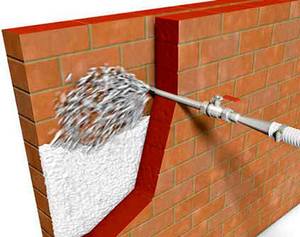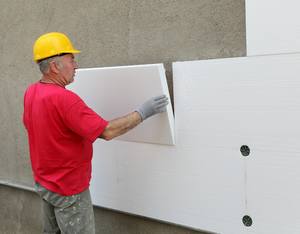Since 25 to 35% of home heat loss is through the walls, insulating these will make a large difference to your comfort and reduce your heating costs. Whilst this is fairly easy for properties with cavity walls, it does present more problems for older properties with solid walls. Cavity wall insulation is generally very cost effective.

Cavity Wall Insulation – picture from www.gosustainable.co.uk
Cavity Wall Insulation
Having the cavity walls filled with insulation material should pay for itself within four years and save around 800kg of carbon emissions each year. Around a quarter of the heat lost from your house is through the walls!
So this along with loft insulation will reduce your heat loss dramatically. Around 60% of heat lost is through the loft and walls combined. Not a saving to be sneezed at and may be able to recover some of the costs through Grants in certain areas and circumstances.
Potential Problems with Cavity Wall Insulation
The purpose of cavity walls was originally just to prevent water penetrating the inside of the house by putting an air gap between the outer and inner skins. Filling this cavity and bridging that air gap presents a risk of water penetrating the house causing damp and mould problems.
With new builds a vapour barrier is installed in the cavity but this isn’t possible in retro-fitting. In some areas of Wales and other parts of the UK frequently subject to strong winds and driving rain, damp has been a problem for home owners. The cost of removal of cavity wall insulation can be 5 times more than the original installation.
It must be said that the vast majority are very happy with their cavity wall insulation but there is a risk, especially if the installer doesn’t do the job properly. For help and advice with cavity wall insulation problems and very impartial advice, contact www.cavityinsulationhelp.co.uk
Usually the process is very simple and is carried out by Contractors. On a normal size house, the process will take just a few hours. Because the fibres (usually mineral wool or polystyrene beads) are pumped through holes in the wall, there is no mess involved.
Solid Wall Houses – Wall Insulation
With properties with solid walls, cavity wall insulation is not possible. There are just two options, insulating the outside of the wall or the inside of the wall. Both are far more expensive and have potential problems. Unless undertaken as part of a general refurbishment or subsidised, it is doubtful that they are economically cost-effective. From a greenhouse gas emissions viewpoint they are worth undertaking.
Internal Wall Insulation
Usually the existing plaster is stripped off the wall and a vapour barrier followed by insulation fixed in place. The wall is then re-plastered and re-decorated. This involves a lot of disruption and can be quite expensive as often electrical points, radiators etc will need moving and window sills replacing.
Once finished the room will be slightly smaller than it was originally. This is a job that can be undertaken by a competent DIY person but is more normally undertaken by a builder or insulation contractor.
External Wall Insulation

External Wall Insulation
Here the insulation is placed on the outside of the property and then covered with a render. Handled properly it should be problem free but there have been some reports of the rendering cracking after installation allowing water penetration into the building.
The advantages over internal wall installation are that there is no disruption inside the house to the family and room sizes are unaffected. Apart from some concerns over the life of the installation, the other drawback is that it is the most expensive option by far, typically over £10,000.
Contractors
If using a contractor make certain he is insured and can provide an insurance based guarantee. To ensure the contractor is bone fide contact the National Insulation Association. It is also worth checking with your local council planning department and doing some internet searches on the firm. Most contractors will be able to advise of any grant aid that may be available for your loft installation.
Articles on Energy Saving, Green Energy and Alternative Energy
- 6 Frugal Ways to Keep Warm this Winter
- Energy Saving Tips for Your Home
- Energy Switching and the Price Cap – How Households can Save
- How to Save Money by Using Solar Energy
- Insulating Rented Homes – Reduce Your Energy Bills
- Insulation – Save Energy! An Overview of Insulating Your Home
- Reducing your energy bills in 2023
- Saving Money by Being Green – or Wasting Money?
- Simple ways to make your home more energy efficient
- Some Simple Solar Projects You Can Do At Home
- Loft Insulation – Comparing Loft Insulation Materials and Methods
- Wall Insulation – Different Methods of Wall Insulating
- Windows, Reducing Heat Loss & Double Glazing
- Standby Electricity Costs – Save Energy!
- Reduce Your Electricity Bills! Ten Electricity Saving Tips
- Low Energy Light Bulbs: LED, CFL & Halogen Explained
- Saving Water & Rainwater Harvesting

